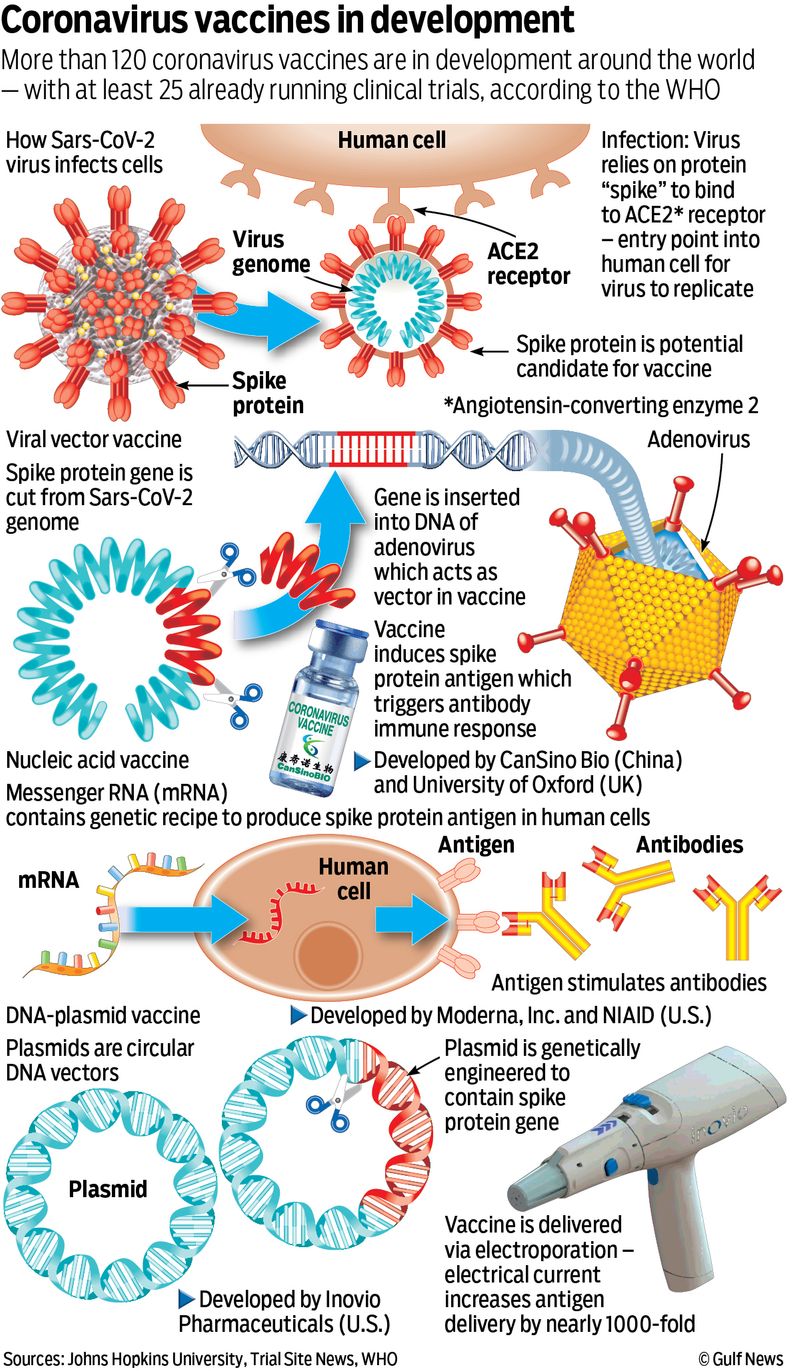CHICAGO/BERLIN: The handful of drugmakers dominating the global coronavirus vaccine race are pushing the boundaries of vaccine technology. The next crop under development feature more conventional, proven designs.
The world will need several different vaccines to fight the COVID-19 pandemic, given the sheer size of global need, variations in effects on different populations, and possible limits of effectiveness in the first crop. Many leading candidates now in final-stage testing are based on new, largely unproven technology platforms designed to produce vaccines at speed.
They include messenger RNA (mRNA) technology used by Moderna Inc and Pfizer Inc with partner BioNTech SE , and inactivated cold virus platforms used by Oxford University/AstraZeneca Plc, Johnson & Johnson and CanSino Biologics, whose vaccine has been approved for military use in China.
Merck & Co in September started testing a COVID-19 vaccine based on a weakened measles virus that delivers genes from the new coronavirus into the body to stimulate an immune response to the coronavirus. Of these, only the technology offered by J&J and CanSino that use cold viruses as vectors to deliver coronavirus genetic material have ever produced a licensed vaccine - for Ebola.
Proven platforms
The next set of candidates - with late-stage trial results expected in the first half of 2021 - are heavily skewed toward approaches that have produced successful vaccines.
Conventional methods include using a killed or inactivated version of the pathogen that causes a disease to provoke an immune response, such as those used to make flu, polio and rabies vaccines. Also more common are protein-based vaccines that use purified pieces of the virus to spur an immune response. Vaccines against whooping cough, or pertussis, and shingles employ this approach.

French drugmaker Sanofi is developing a protein-based COVID-19 vaccine employing the same approach it uses for its Flublok seasonal flu vaccine. Sanofi expects to start the final phase of testing in early December, with approval targeted in the first half of 2021. While Novavax Inc has not yet produced a licensed vaccine, it is using similar purified protein technology and expects to start a late-stage U.S. trial involving 30,000 volunteers in late November.
"Those are more traditional approaches, so we can feel more comfortable that we have a lot of experience with them," said Dr. Paul Offit, director of the Vaccine Education Center at Children's Hospital of Philadelphia. Offit also sees promise in some of the inactivated virus vaccines being developed by Chinese researchers, including Sinopharm's China National Biotec Group (CNBG), one of the few first-crop developers using a traditional technique.
Other second-wave developers are making vaccines based on virus-like particles (VLPs), which mimic the structure of the coronavirus but contain no genetic material from it.
Vaccines based on virus-like particles
VLP vaccines can be produced in a variety of different types of cells, including mammal, bacterial, insect, yeast and plant cells. This approach has been used to develop vaccines for hepatitis B and human papillomavirus. Quebec's Medicago is testing a VLP COVID-19 vaccine grown in tobacco plants with the backing of tobacco company Philip Morris .

Medicago has yet to produce an approved vaccine, but has completed large-scale testing for a seasonal flu vaccine using this approach. It plans to begin mid-stage trials of its COVID-19 vaccine next month and aims to make up to 1 billion doses a year by 2023. Others are looking at alternative delivery methods, such as the nasal spray vaccine being developed by a team at Xiamen University, Hong Kong University and Beijing Wantai Biological Pharmacy Enterprise, which is based on a modified flu virus.
Challenges ahead
The second crop, however, could face problems completing large studies if the current leaders bring their vaccines over the finish line in the coming months. "If we get a super vaccine in December, from company x, which is on the market, it will be difficult to recruit participants into other studies," said Peter Kremsner from the University Hospital in Tuebingen, Germany.
"Then everyone will say, if the vaccine exists, I will get vaccinated now with this vaccine. This will definitely prove a problem for recruitment" added Kremsner, who is testing CureVac's mRNA COVID-19 vaccine in early clinical trials with backing from the Bill & Melinda Gates Foundation.
On the flip side, it is easier and faster to prove efficacy when community spread of the virus is rampant as is happening again in the United States, Europe and elsewhere, a potential advantage for companies starting large-scale vaccine trials in the near future.
from World,Europe,Asia,India,Pakistan,Philipines,Oceania,Americas,Africa Feed https://ift.tt/35IOmBF
No comments:
Post a Comment